Universal Navigation
Meeting the Needs of Every User
With the advent of navigation technology, getting lost has become a thing of the past. It was not so long ago that navigation systems were considered rather expensive gadgets offering limited functionality. Today?s navigation systems, however, are commonplace, affordable and on the wish list of many people. What modern technology can do is the subject of many articles, so in this one we focus on what it should do, taking as example the concept of universal navigation, or Universal NAVIgation Technology (UNAVIT).
Universal Navigation
UNAVIT is a navigation environment that is primarily accessible through mobile telephones. It is able to provide any user, taking into account their preferences and/or special needs, with navigation information regardless of the physical environment, whether outdoors or indoors. The navigation system should also be capable of adapting to different navigational situations, such as night or daytime, rush hour or during regular traffic-flow hours, and mode of transportation. Here, we consider two types of features for UNAVIT: essential and advanced (Figure 1)
Essential Features
AnyWhere refers to the intended UNAVIT capability for seamless navigation between outdoors and indoors using the same mobile phone and service. Mainly thanks to the availability and affordability of GPS, most current navigation systems are designed only for outdoor use. However, due to advances in technologies such as radio-frequency identification (RFID) and Wi-Fi, there has been growing interest in navigation systems for indoor use. Most systems available today, with the exception of a few experimental ones, operate either outdoors or indoors only; there is currently no system offering seamless navigation as the user moves between the two arenas.
AnyTime means support for time-sensitive situations, such as during rush hours or inclement weather conditions. Although current navigation systems support functionality that allows users to choose criteria for navigating in different situations, they lack this capability. AnyUser offers the possibility to meet the navigation needs and preferences of all users. Modern navigation systems have limitations in this regard. In particular, with the exception of a few designed specifically for these populations, they do not offer features usable by physically or visually impaired individuals.
Advanced Features
Transparency describes how UNAVIT will employ minimum user interaction when assisting users with navigation needs; the system will be easy to use and the intricacies of its operations hidden from the user. Adaptability is a unique feature of UNAVIT, making it able to adapt to different devices (screen size, user interface, etc.), navigation environments (outdoors or indoors), trip purpose, various users (Figure 2) and modes of transportation. In terms of the latter, UNAVIT will be able to adjust navigational requirements should a user driving a car decide to continue on foot. The system will incorporate both road and pavement network information. So, should a pedestrian decide to continue their journey by bicycle, the system will adapt to the change in mode of transport by properly adjusting technologies, data and techniques.
Infrastructure
UNAVIT's infrastructure, in addition to common navigation functions available in current systems, must support the previously mentioned features. Figure 3 delineates the architecture of UNAVIT and its components. These are as follows:
-
NavKiosk, web services responsible for receiving navigation requests from users, along with Navigation Quality of Services (NavQoSs). UNAVIT considers two types of NavKiosk: Outdoor-NavKiosk and Indoor-NavKiosk. Each Outdoor- NavKiosk will have a designated geographical area for which it is responsible. Each building will have an Indoor-NavKiosk responsible for all relevant navigation queries.
-
MetaNav, web services which will act as a directory of services providing information about all NavKiosks, e.g. the geographical extent covered by each, both outdoor and indoor.
-
Query Processing Engine (QPE), web services responsible for interpreting and processing navigation queries received from NavKiosks. Once the requirements of a navigation query through its NavQoSs are understood, the QPE will submit the query to the navigation web-service providers.
-
Navigation Web Service Provider (NavWSP) will provide navigation services such as points of interest (POIs), routeing and directions. NavWSPs can modify existing navigation services or add new navigation services in order to meet the needs of universal navigation. NavWSPs can implement navigation web services by complying with location-based service standards such as the Open Location Services (OpenLS) architecture supported by the Open Geospatial Consortium.
Research Challenges
UNAVIT's design and implementation will require multidisciplinary knowledge and techniques, and pose new research challenges. Regarding the AnyWhere feature, such challenges include developing techniques or standards for supporting seamless navigation between indoor and outdoor environments, representing both sorts of navigation data, and providing location-dependent navigation solutions and information presentation. Research challenges concerning the AnyUser feature include exploring techniques for providing route directions for different modes of transportation, supporting a multi-user interface and navigation, and providing user-centred navigation information presentation. To meet the aims of the AnyTime feature, time-sensitive navigation information must be provided, e.g. the routes between any pair of origin and destination (O-D) addresses might vary according to time of day or travel conditions.

Value staying current with geomatics?
Stay on the map with our expertly curated newsletters.
We provide educational insights, industry updates, and inspiring stories to help you learn, grow, and reach your full potential in your field. Don't miss out - subscribe today and ensure you're always informed, educated, and inspired.
Choose your newsletter(s)
























